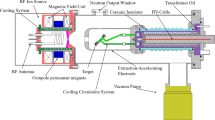Abstract
A compact D–D neutron generator, with a peak neutron yield of D–D reactions up to 2.48 × 108 n/s is being developed at Lanzhou University in China for application in real-time neutron activation analysis. During tests, the problem of back acceleration of secondary electrons liberated from the neutron production target by deuterium ions bombardment was encountered. In this study, an electric field method and a magnetic field method for suppressing secondary electrons are designed and experimentally investigated. The experimental results show that the electric field method is superior to the magnetic field method. Effective suppression of the secondary electrons can be achieved via electrostatic suppression when the bias voltage between the target and the extraction-accelerating electrode is > 204 V. Furthermore, the secondary electron emission coefficient for the mixed deuterium ion (D1+, D2+, and D3+) impacting on molybdenum is estimated. In the deuterium energy range of 80–120 keV, the estimated secondary electron emission coefficients are approximately 5–5.5 for the mixed deuterium ion glancing incidence of 45° and approximately 3.5–3.9 for the mixed deuterium ion normal incidence.








Similar content being viewed by others
References
H.Z. Bilheux, R. Mcgreevy, I.S. Anderson, Neutron Imaging and Applications (Springer, Boston, 2009), p. 67
International Atomic Energy, Neutron Generators for Analytical Purposes, IAEA Radiation Technology Reports No. 1, IAEA, Vienna (2012)
J.I.A. Fuquan, G.U. Deshan, C. Daowen et al., An neutron generator-based NIPGA system for on-site analysis. Nucl. Sci. Tech. 21(1), 63–64 (2010). https://doi.org/10.13538/j.1001-8042/nst.21.63-64
R. Ravisankar, P. Eswaran, N. Seshaderssan et al., Instrumental neutron activation analysis of beachrock samples of South East Coast of Tamilnadu, India. Nucl. Sci. Tech. 18(4), 204–211 (2007). https://doi.org/10.1016/S1001-8042(07)60047-5
Z.W. Huang, J.R. Wang, Z. Wei et al., Development of a compact DD neutron generator. J. Instrum. 13(01), P01013 (2018). https://doi.org/10.1088/1748-0221/13/01/P01013
A.G. Hill, W.W. Buechner, J.S. Clark et al., The emission of secondary electrons under high energy positive ion bombardment. Phys. Rev. 55(5), 463 (1939). https://doi.org/10.1103/PhysRev.55.463
I.H. Tan, M. Ueda, R.S. Dallaqua et al., Magnetic suppression of secondary electrons in plasma immersion ion implantation. Appl. Phys. Lett. 86(2), 023509 (2005). https://doi.org/10.1063/1.1852704
H.C. Bourne Jr., R.W. Cloud, J.G. Trump, Role of positive ions in high-voltage breakdown in vacuum. J. Appl. Phys. 26(5), 596–599 (1955). https://doi.org/10.1063/1.1722047
R. Adams, L. Bort, R. Zboray et al., Development and characterization of a D-D fast neutron generator for imaging applications. Appl. Radiat. Isot. 96, 114–121 (2015). https://doi.org/10.1016/j.apradiso.2014.11.017
M.A. Wasaye, H. Wang, P. He, An algorithm for Monte Carlo simulation of bremsstrahlung emission by electrons. Nucl. Sci. Tech. 28(5), 65–73 (2017). https://doi.org/10.1007/s41365-017-0218-7
J.E. Bounden, P.D. Lomer, J. Wood, A neutron tube with constant output (1010 n/sec) for activation analysis and reactor applications. Nucl. Instrum. Methods. 33(2), 283–288 (1965). https://doi.org/10.1016/0029-554X(65)90055-8
S.G. Forbes, E.R. Graves, R.N. Little, Low voltage 14 MeV neutron source. Rev. Sci. Instrum. 24(6), 424–427 (1953). https://doi.org/10.1063/1.1770737
A.S. Tsybin, A.E. Shikanov, Neutron generation in small sealed accelerating tubes. Russ. Phys. J. 28(8), 609–632 (1985). https://doi.org/10.1007/BF00895162
I.J. Kim, H.D. Choi, Development of D–D neutron generator. Nucl. Instrum. Meth. B 241(1–4), 917–920 (2005). https://doi.org/10.1016/j.nimb.2005.07.170
C. Waltz, M. Ayllon, T. Becker et al., Beam-induced back-streaming electron suppression analysis for an accelerator type neutron generator designed for 40Ar/39Ar geochronology. Appl. Radiat. Isot. 125, 124–128 (2017). https://doi.org/10.1016/j.apradiso.2017.04.017
B. Goplen, L. Ludeking, D. Smith et al., User-configurable MAGIC for electromagnetic PIC calculations. Comput. Phys. Commun. 87(1–2), 54–86 (1995)
H. Nguyen, J. Mankowski, J.C. Dickens et al., Calculations of secondary electron yield of graphene coated copper for vacuum electronic applications. AIP Adv. 8(1), 015325 (2018). https://doi.org/10.1063/1.5019360
J.L. Wurtz, C.M. Tapp, Secondary electron emission from scandium, erbium, scandium deuteride, and erbium deuteride under deuteron bombardment. J. Appl. Phys. 43(8), 3318–3324 (1972). https://doi.org/10.1063/1.1661714
J.L. Ke, M. Liu, C.G. Zhou, Deuteron induced secondary electron emission from titanium deuteride surface. Nucl. Instrum. Meth. B 280, 1–4 (2012). https://doi.org/10.1016/j.nimb.2012.02.033
M. Liu, J.L. Ke, G. Huang et al., Measurement of the secondary electrons emission coefficiency from molybdenum induced deuteriums (Nucl. Electron. Detect. Technol., Beijing, 2012). (in Chinese)
R.A. Langley, J. Bohdansky, W. Eckstein et al., Data compendium for plasma-surface interactions. Nucl. Fusion 24(S1), S9 (1984). https://doi.org/10.1088/0029-5515/24/S1/001
S.B. Svensson, G. Holmen, A. Buren, Angular dependence of the ion-induced secondary-electron yield from solids. Phys. Rev. B 24(7), 3749 (1981). https://doi.org/10.1103/PhysRevB.24.3749
G.W. McClure, High-voltage glow discharges in D2 gas. I. Diagnostic measurements. Phys. Rev. 124(4), 969 (1961). https://doi.org/10.1103/PhysRev.124.969
B.H. Sun, Q. Chen, Characteristics of intense beam for a duoplasmatron source. Nucl. Tech. 14(12), 731–737 (1991). (in Chinese)
Author information
Authors and Affiliations
Corresponding authors
Additional information
This work was supported by the National Key Scientific Instrument and Equipment Development Project of China (2013YQ40861), the National Natural Science Foundations of China (11875155, 11705071), and the Fundamental Research Funds for the Central Universities of China (lzujbky-2019-kb09).
Rights and permissions
About this article
Cite this article
Huang, ZW., Bai, XH., Liu, CQ. et al. Study on secondary electron suppression in compact D–D neutron generator. NUCL SCI TECH 30, 86 (2019). https://doi.org/10.1007/s41365-019-0596-0
Received:
Revised:
Accepted:
Published:
DOI: https://doi.org/10.1007/s41365-019-0596-0




